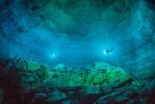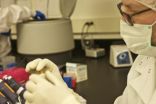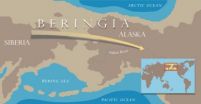(Press-News.org) RENO, Nev. – Like a detective story with twists and turns in the plot, scientists at the University of Nevada, Reno are unfolding a story about the rapid uplift of the famous 400-mile long Sierra Nevada mountain range of California and Nevada.
The newest chapter of the research is being published today in the scientific journal Nature, showing that draining of the aquifer for agricultural irrigation in California's Central Valley results in upward flexing of the earth's surface and the surrounding mountains due to the loss of mass within the valley. The groundwater subsidence was found to also correlate with seismic activity on the San Andreas Fault.
University of Nevada, Reno Research Professor Geoff Blewitt also told the story in a presentation at the European Geophysical Sciences Union conference in Vienna, Austria on April 28. The annual EGU General Assembly is the largest and most prominent European geosciences event. It attracts over 11,000 scientists from all over the world.
"We first wrote two years ago about the rapid rise of the Sierra, with its 14,000-foot peaks in the south and 10,000-foot peaks at Lake Tahoe, moving as much as 1 to 3 millimeters per year," said Blewitt, of the Nevada Bureau of Mines and Geology, a division of the College of Science. "The puzzling results of our earlier research cannot be explained easily by geology alone. We've now found that a reason for the rapid uplift may be linked to human activity."
Over the past 150 years, around 40 trillion gallons of groundwater in California's Central Valley has been lost through pumping, irrigation and evapotranspiration. That's roughly equal to all the water in Lake Tahoe, the volume of which can cover the entire state of California in 14 inches of water.
"This massive withdrawal of water has relieved pressure on the Earth's crust, which is now rebounding upwards in response," Blewitt said. "This is counter-intuitive to most people, even geologists, who tend to only think that water withdrawal causes subsidence, which is only true in the sediments of the valley from which the water is withdrawn. With the weight of the groundwater missing, the hard-rock crust under the valley is actually rising too."
The rise is quite fast in geologic time, with these mountain ranges rising by a similar amount each year – about the thickness of a dime – with a cumulative rise over the past 150 years of up to 6 inches, according to the calculations by the team of geophysicists.
Blewitt and colleague Bill Hammond, who run the Nevada Geodetic Laboratory at the University of Nevada, Reno, partnered with the University of Western Washington, the University of California, Berkeley and the University of Ottawa in the research.
"The real importance of this research is that we are demonstrating a potential link between human activity and deformation of the solid Earth, which explains current mountain uplift and the yearly variation in seismicity," said Colin Amos, assistant professor of geology from Western Washington University and lead author of the Nature article. "These are questions that lots of geologists have been puzzling over, and it's a real eye opener to think that humans are the ultimate cause."
The study is based on detailed GPS measurements from California and Nevada between 2007 and 2010. Also working on the study were Pascal Audet of the University of Ottawa and Roland Bürgmann, professor of earth and planetary science at the University of California, Berkeley. The detailed GPS analysis was performed by Hammond and Blewitt with support from the National Science Foundation.
Hammond and Blewitt use data from their Nevada Geodetic Lab and its MAGNET GPS Network, the largest GPS data-processing center in the world, able to process information from about 12,000 stations around the globe continuously, 24/7. The facility measures the shape of the Earth every day using data drawn in from the global network with stations on every continent around the planet, including more than 1,200 stations from the NSF EarthScope Plate Boundary Observatory, as well as stations in space. The space-based radar data comes from the European Space Agency with support from NASA.
"We can sense the long-term flexing of the crust that accompanies trends in climate and related seasonal changes in the Earth's surface that track yearly precipitation," Hammond said. "The processing facility at the Nevada Geodetic Laboratory makes it possible to interpret trends in over 500 locations in southern California, needed to measure the centimeter-scale changes these loads produce. It makes it possible for scientists to connect climatic changes to subsidence patterns and the rate of earthquake occurrence."
"The data is like a gold mine, we keep digging for new discoveries," he said. "Scientists around the world use it extensively for research such as modeling earthquakes and volcanoes."
INFORMATION:
The article in Nature, "Uplift and seismicity driven by groundwater depletion in central California," can be found online at http://www.nature.com.
For the Nevada Geodetic Laboratory and geodetic information go to http://geodesy.unr.edu/index.php.
Research finds human impact may cause Sierra Nevada to rise, increase seismicity of San Andreas Fault
University of Nevada, Reno researchers go to science conference in Vienna to present findings
2014-05-15
ELSE PRESS RELEASES FROM THIS DATE:
A skeleton clue to early American ancestry
2014-05-15
This news release is available in Spanish and Arabic.
The discovery of a near-complete human skeleton in a watery cave in Mexico is helping scientists answer the question, "Who were the first Americans?" The finding, reported in the 16 May issue of the journal Science, sheds new light on a decades-long debate among archaeologists and anthropologists.
Deciphering the ancestry of the first people to populate the Americas has been a challenge.
On the basis of genetics, modern Native Americans are thought to descend from Siberians who moved into eastern Beringia (the ...
Oldest most complete, genetically intact human skeleton in New World
2014-05-15
WASHINGTON (May 15, 2014)—The skeletal remains of a teenage female from the late Pleistocene or last ice age found in an underwater cave in Mexico have major implications for our understanding of the origins of the Western Hemisphere's first people and their relationship to contemporary Native Americans.
In a paper released today in the journal Science, an international team of researchers and cave divers present the results of an expedition that discovered a near-complete early American human skeleton with an intact cranium and preserved DNA. The remains were found surrounded ...
WSU anthropologist leads genetic study of prehistoric girl
2014-05-15
PULLMAN, Wash.—For more than a decade, Washington State University molecular anthropologist Brian Kemp has teased out the ancient DNA of goose and salmon bones from Alaska, human remains from North and South America, and human coprolites—ancient poop—from Oregon and the American Southwest.
His aim: use genetics as yet another archaeological record offering clues to the identities of ancient people and how they lived and moved across the landscape.
As head of the team studying the DNA of Naia, an adolescent girl who fell into a Yucatan sinkhole some 12,000 years ago, he ...
Genetic study helps resolve years of speculation about first people in the Americas
2014-05-15
CHAMPAIGN, Ill. — A new study could help resolve a longstanding debate about the origins of the first people to inhabit the Americas, researchers report in the journal Science. The study relies on genetic information extracted from the tooth of an adolescent girl who fell into a sinkhole in the Yucatan 12,000 to 13,000 years ago.
The girl's remains were found alongside those of ancient extinct beasts that also fell into the "inescapable natural trap," as researchers described the sinkhole. The team used radiocarbon dating and analyzed chemical signatures in bones and ...
Dating and DNA show Paleoamerican-Native American connection
2014-05-15
Eastern Asia, Western Asia, Japan, Beringia and even Europe have all been suggested origination points for the earliest humans to enter the Americas because of apparent differences in cranial form between today's Native Americans and the earliest known Paleoamerican skeletons. Now an international team of researchers has identified a nearly complete Paleoamerican skeleton with Native American DNA that dates close to the time that people first entered the New World.
"Individuals from 9,000 or more years ago have morphological attributes -- physical form and structure -- ...
Genetic study confirms link between earliest Americans and modern Native-Americans
2014-05-15
AUSTIN, Texas — The ancient remains of a teenage girl found in an underwater Mexican cave establish a definitive link between the earliest Americans and modern Native Americans, according to a new study released today in the journal Science.
The study was conducted by an international team of researchers from 13 institutions, including Deborah Bolnick, assistant professor of anthropology at The University of Texas at Austin, who analyzed DNA from the remains simultaneously with independent researchers at Washington State University and the University of Illinois at Urbana-Champaign.
The ...
First 'heavy mouse' leads to first lab-grown tissue mapped from atomic life
2014-05-15
Scientists have created a 'heavy' mouse, the world's first animal enriched with heavy but non-radioactive isotopes - enabling them to capture in unprecedented detail the molecular structure of natural tissue by reading the magnetism inherent in the isotopes.
This data has been used to grow biological tissue in the lab practically identical to native tissue, which can be manipulated and analysed in ways impossible for natural samples. Researchers say the approach has huge potential for scientific and medical breakthroughs: lab-grown tissue could be used to replace heart ...
One of oldest human skeletons in North America is discovered
2014-05-15
Cave-diving scientist Patricia A. Beddows of Northwestern University is a member of an international team of researchers and cave divers this week announcing the discovery in an underwater Yucatán Peninsula cave of one of the oldest human skeletons found in North America.
Details of "Naia," a teenage girl who went underground to seek water and fell to her death in a large pit named Hoyo Negro ("black hole" in Spanish), will be published May 16 in the journal Science.
"The preservation of all the bones in this deep water-filled cave is amazing -- the bones are beautifully ...
Communicating with the world across the border
2014-05-15
Stanford, CA—All living cells are held together by membranes, which provide a barrier to the transport of nutrients. They are also the communication platform connecting the outside world to the cell’s interior control centers. Thousands of proteins reside in these cell membranes and control the flow of select chemicals, which move across the barrier and mediate the flux of nutrients and information. Almost all of these pathways work by protein handshakes--one protein “talking” to another in order to, for example, encourage the import of a needed nutrient, to block a compound ...
Quantum simulator gives clues about magnetism
2014-05-15
Assembling the puzzles of quantum materials is, in some ways, like dipping a wire hanger into a vat of soapy water, says CIFAR (Canadian Institute for Advanced Research) Fellow Joseph Thywissen (University of Toronto).
Long before mathematical equations could explain the shapes and angles in the soap foams, mathematicians conjectured that soap films naturally found the geometry that minimized surface area, thus solving the problem of minimal surfaces. They could be created simply by blowing soap bubbles.
At the University of Toronto's Ultracold Atoms Lab, Thywissen ...
LAST 30 PRESS RELEASES:
The perfect plastic? Plant-based, fully saltwater degradable, zero microplastics
Bias in data may be blocking AI’s potential to combat antibiotic resistance
Article-level metrics would provide more recognition to most researchers than journal-level metrics
Satiety’s little helper: Protein that supports appetite regulating protein identified
UF dives deep into predicting storm damage with computer models
A stormy ocean voyage yields insights on the global carbon cycle
Scientists identify first non-coding gene that controls cell size
Demonstration of altermagnetism in RuO₂ thin films -- A new magnetic material for the AI era
Penn researchers awarded $25M to conduct trial using smartphones to fight heart disease
PCORI awards funding for new patient-centered healthcare research
Exploring the origins of the universe: 145 low-noise amplifiers complete ALMA telescopes
Empress cicada wings help illuminate molecular structure
Using sound waves to detect helium
Time burden in patients with metastatic breast and ovarian cancer from clinic and home demands
Researchers discover bias in AI models that analyze pathology samples
Scientists ID potential way to prevent brain injuries from triggering Alzheimer's
MASTER 2nd Open Call: Execution period kick-off
Algae for health in food and pharma
Advanced microrobots driven by acoustic and magnetic fields for biomedical applications
Chicago health information leader recognized for raising CPR readiness and blood pressure awareness
The Intimate Animal, a new book from Kinsey Institute Executive Director Dr. Justin Garcia
When blue-collar workers lose union protection, they try self-employment
New video dataset to advance AI for health care
MEA-based graph deviation network for early autism syndrome signatures in human forebrain organoids
New modeling approach sheds light on rare gut disease
Study documents potentially hazardous flame retardants in firefighter gear
Can certain bacteria regulate aging of the immune system and its related alterations?
AI model helps diagnose often undetected heart disease from simple EKG
There are fewer online trolls than people think
Cell membrane fluctuations produce electricity
[Press-News.org] Research finds human impact may cause Sierra Nevada to rise, increase seismicity of San Andreas FaultUniversity of Nevada, Reno researchers go to science conference in Vienna to present findings






